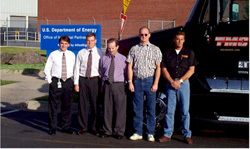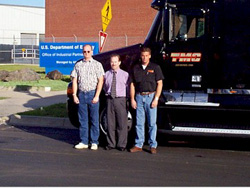Letting Up on the Gas

One Inventor’s Device Looks to the Driver not the
Engine for Fuel Economy
By Bryan Hunter

What do small-town Radcliffe, Iowa and cutting-edge transportation technology
have in common? Probably nothing if it were not for the 20-year vision of Dwayne
Fosseen. Almost single-handedly, Fosseen has managed to put Radcliffe on the map
as a world leader in fuel-economy and emission-control technology. Fosseen’s
long-term research and development have resulted in two interrelated devices
that combine to revolutionize cruise-control technology for commercial
applications.
Last September, a tractor-trailer made a historic journey from Kansas City,
Missouri to Des Moines, Iowa. The occasion marked nothing as historical as the
Wright Flyer or the Louis and Clark expedition, but Fosseen was still pleased.
Fosseen is president and chairman of Mirenco Inc., and also the inventor of the
device. The brainchild for the invention was born out of the 1976 oil crisis;
that’s when Fosseen realized there might be a need for some type of device
concerned with vehicle exhaust emission and increased fuel mileage.
The first product he launched into the marketplace did
just what he had resolved to do - increased fuel economy while controlling
vehicle emissions - all in a black box that attached to the existing engine.
Even better, Fosseen got some endorsements from Uncle Sam; the United States
Department of Energy developed his DriverMax from Fosseen’s patent. (The device
can be used on passenger cars.)
“I’ve spent years working on environmental issues,” Fosseen said. “One of the
simplest and most overlooked solutions to a cleaner environment and fuel mileage
is to simply take it easy on the vehicle throttle. Everybody’s looking for some
magic catalytic converter or fuel, but they aren’t looking at the first and
simplest solution.

"With every vehicle in the world today, there’s only two positions on the
throttle that are preset: Idle and wide-open; all managed by a foot or hand or
cruise control. I think most engine manufacturers are striving for more
horsepower, and most of the time you only need a fraction of the available
horsepower.”
Engineers for the U.S. Department of Energy (pictured) helped develop DriverMax
from Fosseen's Patent.
The Method’s Behind DriverMax’s Economy
Introduced in 1997, DriverMax is an automated fuel
management system designed to improve fuel mileage, maintenance costs, and
emission amounts by precisely regulating the amount of fuel injected into diesel
engines. Diagnostic testing indicates that the DriverMax alone delivers 10
percent fuel savings and 60 percent exhaust reduction, not to mention reduced
engine wear-and-tear from less efficient throttle control. The DriverMax unit
(which should not be confused with conventional cruise control) sells for under
$500.
To maximize the benefit of Mirenco's throttle control system, however, DriverMax
may be combined with EconoCruise, a newly released device utilizing global
positioning satellite (GPS) technology. EconoCruise was effectively demonstrated
on a drive from Kansas City to Des Moines. Whereas before DriverMax had
preformed admirably in stop-and-go applications, the successful Kansas City-Des
Moines run demonstrated that when combined with EconoCruise, the throttle
control system solved the problem of how to combine GPS technology with an
electronically-controlled vehicle throttle for sustained highway travel.
EconoCruise calculates and stores a driver's acceleration patterns along a given
route while driving, so that when DriverMax and EconoCruise are engaged along
the same route in the future, speed and throttle control are determined by the
vehicle's geographical position. In order to gather data for storing in the
memory of each truck's system, Fosseen recommends that a fleet owner uses his
best drivers--those familiar with the route being stored and long-experienced
with the rig--on the initial, data storing run. Such a practice combines the
expertise of professional drivers with the technology of the Mirenco systems, so
that the "perfect" run can be reduplicated any time and with any driver behind
the wheel.
EconoCruise calculates and stores a driver's acceleration patterns along a given
route while driving, so that when DriverMax and EconoCruise are engaged along
the same route in the future, speed and throttle control are determined by the
vehicle's geographical position.
Fosseen points out that standard cruise-control technology is not effective for
maximizing fuel economy. "There are ideal places [along the road] to lose and
gain momentum, which a good driver knows how to take advantage of but cruise
control can't adjust for," Fosseen explains. And while much attention has
rightfully been directed towards catalytic converters and improved fuel formulae
for enhancing engine performance and emission control, Fosseen is quick to
remind that the first place to look for improved fuel efficiency and reduced
emissions should be the throttle at the driver's foot. Even the most experienced
driver has a tendency to "punch" the throttle at times, a practice that reduces
both fuel efficiency and engine life.
When the driver engages the system, EconoCruise uses GPS positioning to relay to
DriverMax in real-time the vehicle's highway location. This location information
is then calculated with the truck's current speed. With these two bits of data,
DriverMax feeds the optimal throttle position to the engine. The result is an
intelligent cruise-control system that is adaptable to all vehicles worldwide.
Should the driver need to disengage the system while driving, a tap of the
brakes or a press of the foot throttle allows for manual override, just as with
conventional cruise control.
Improved fuel efficiency, emission control, and engine life all add up to
long-term savings. For a relatively small initial monetary investment, Mirenco's
products mean money in the operator's pocket in the long term. DriverMax and
EconoCruise are transportation-improvement devices that continuously pay for
themselves into the future.
“A fleet can recognize its best drivers and build a program around them into all
of the vehicles,” Fosseen said. “If a route has been run before, the truck will
recognize it.”
 |
Mirenco believes that standard cruise-control technology is not effective for
maximizing fuel economy. US DOE and TMC standing in front of the TMC truck used
to demonstrate and prove the technology. |
|
|
|
|